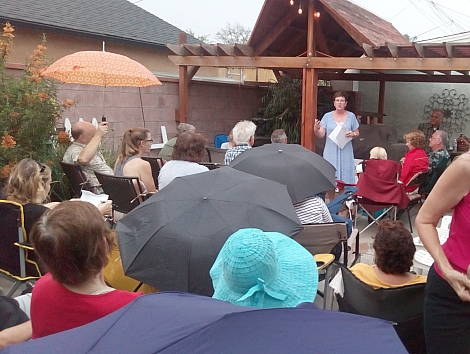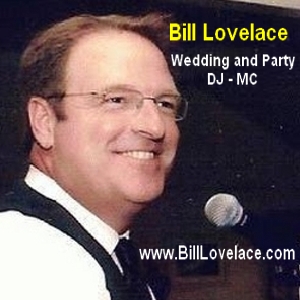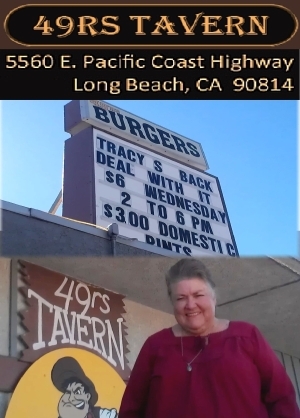
[Scroll down for further.]
| (Sept. 4, 2017, 2:20 p.m.) -- It was so humid that it began to rain, driving over fifty ELB residents from the backyard of a South of Conant neighborhood home into the homeowner's living room, kitchen and dining area.
[Scroll down for further.] |
They interrupted their Labor Day holiday weekend to attend a Sunday Sept. 3 grassroots meeting, first mentioned on NextDoor.com only two days earlier, to discuss details of density-inviting Sacramento legislation and city staff proposed land use changes that could affect their neighborhood and neighborhoods beyond. Organizers discussed SB 35, a pending Sacramento bill that could in many cases let developers build multi-unit rental projects without providing parking at levels required by current LB zoning, without currently required public testimony and environmental impact disclosures of neighborhood impacts, no longer subject to City Hall discretionary approvals. They also displayed a map, revised by city staff in August [and reported weeks ago by LBREPORT.com here] showing areas proposed for mixed use density (commercial + residential uses) and increased building heights. Dark purple areas on the maps would allow "mixed uses" that combine commercial and residential uses; red areas are purely commercial. Organizers alerted residents to the fact that increased building heights on the maps might end up higher with "density bonuses" allowed under current law and future Sac'to legislation.
Organizers Kimberley Toscas (holding map right in photo), Raman Vasishth (holding map left in photo) and Angela Kimball (partially obscured by map) didn't spend time criticizing elected officials; they conveyed as much information as they could...and let the information speak for itself (including sometimes wonky details that residents seemed eager to learn.) At the conclusion of the meeting, they urged residents to share what they learned with their neighbors (online and in person) and recommended that they convey their views (by phone and by email) to their City Council and Sac'to representatives. They also indicated that they plan to put their information online (via NextDoor.com) and hold additional neighborhood meetings of the same type.
Ms. Toscas, a teacher in a nearby school district, used her classroom skills to convey the issues from a neighborhood taxpayer perspective. She began by referencing and paraphrasing the views of an experienced community planner who has authored material cautioning communities about potential poor outcomes and harmful consequences of "smart growth" when not smartly applied (Eben Fodor's The Myth of Smart Growth.), and then localized the issues by discussing pending CA legislation (SB 35) and LB city staff's proposed revision of the city's Land Uses.
Ms. Toscas: ...What "smart growth" really does, it's fundamentally a pro-growth planning philosophy...The problem with the "smart growth" planning advocates is they tend to use this catch phrase if "responsible planning" to preemptively sweep critical aspects of the debate about all of this growth under the table, under the rug, and out of public dialogue...Their attitude is they don't really care about us...While [smart growth] is decidedly pro growth, it misleadingly portrays itself as the ultimate growth solution. And it's not.
Mr. Vasishth distributed written materials he prepared based on city staff's proposed map and Land Use text. It listed 5th district locations where city staff has proposed increased density (from the Los Altos Gateway (Bellflower/Spring) to Old Lakewood Village. Ms. Toscas noted that "people in Wrigley have been fighting this I think for a long time. And they have a lot of art deco buildings that have been lost to high density. They're very, very upset about it so they've been very actively involved in pursuing less density, less pulling down of those architecturally significant buildings and changing the fabric of their neighborhoods. And I think in one of the Planning [Commission] meetings they were so upset about it that they decided to push more density over here. [audience displeasure] Let's not let that divide and conquer us, because ultimately the whole city needs to be united against this."
Asked about joining with Belmont Heights residents whose neighborhoods lost craftsman-style single family homes to Council-enabled "crackerbox apartment" density in the 1980s, Ms. Toscas said the recently-revived Council of Neighborhood Organizations (CONO) under Robert Fox has done a good job of educating neighborhood groups about that history. She added that city staff current proposals now go beyond "crackerbox" apartments and invite high-rise-type rental units. "That's what we risk all across Long Beach," Ms. Toscas said. Ms. Kimball said the proposed density increases would further strain LB's already-thin police and fire levels, less-open libraries, local water and electricity infrastructure and schools. "We're just really encouraging you to really reach out to your neighbors and talk to your neighbors and get them involved. If you can talk to two or three neighbors and keep spreading this exponentially, that's how you build support."
Residents thanked the meeting organizers for their work, and the organizers said they plan to put the materials online using NextDoor.com with additional neighborhood meetings to be announced. Following push-back against city staff's August-proposed maps, city officials have scheduled four "community meetings" of their own starting in late September and extending into October. At those meetings, city staff will hear "public input" and possibly revise the proposed density maps before bringing them to LB's Planning Commission. The Planning Commission (a non-elected, Mayor-chosen/Council approved body) can then send its non-binding recommendations on the increased density maps to LB's elected City Council, which will ultimately decide on density/height changes in the city's Land Use Element. Developing. blog comments powered by Disqus Recommend LBREPORT.com to your Facebook friends:
Follow LBReport.com with:
Contact us: mail@LBReport.com |
   
 Hardwood Floor Specialists Call (562) 422-2800 or (714) 836-7050  |